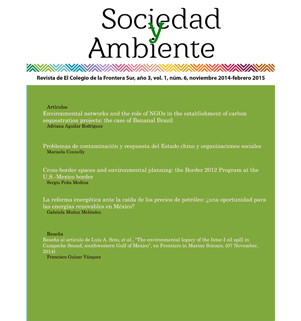Resumen
The objective of this article is twofold: first, to describe a pedagogical objective linking planning and policy concepts to the study of borderlands issues; second, to discuss the institutional framework of environmental planning at the U.S.-Mexico border. The Border 2012 program is used as a benchmark to discuss policy objectives, challenges and the shortcomings of cross-border environmental planning. The methodology followed is a program evaluation related to institutional design. The main conclusion is that environmental policy at the border has overlooked land use planning as an important tool for achieving environmental goals as set out by Border 2012. It is important to incorporate a mechanism that will allow better intergovernmental coordination and cooperation in land use planning policy.
Citas
Azuela de la Cueva, Antonio (1989). La ciudad, la propiedad privada y el derecho. Mexico: El Colegio de México, 278 p.
Barry, Tom and Sims, Beth (1994). The Challenge of Cross-border Environmentalism: The U.S.-Mexico Case. Albuquerque, NM: Resource Center Press, 121 p.
Black, Henry (1991). Black’s Law Dictionary. St.Paul, MN: West Publishing Co., 1133 p.
Brenner, Neil (1999). “Globalisation as Reterritorialisation: The Re-scaling of Urban Governance in the European Union” en Urban Studies, 36 (3), Sage Publication, pp. 431- 451.
Bromley, Daniel (2006). Sufficient Reason; Volitional Pragmatism and the Meaning of Economic Institutions. Princeton, NJ: Princeton University Press, 244 p.
Brown, Christopher &. Mumme, Stephen (2000). “Applied and theoretical aspects of binational watershed councils (Consejos de Cuencas) in the US-Mexico borderlands”. Natural Resources Journal. 40, 895-929.
Cordova y Vazquez, Ana & Carlos De La Parra, (Eds.) ( 2007). A Barrier to our Shared Environment. The Border Fence between the United States and Mexico. Mexico: SEMARNAT-INE, COLEF, SCERP, 206 p.
Faludi, Andreas (2002). “The European Spatial Development Perspective (ESDP): An Overview” En European Spatial Planning. Andreas Faludi (Ed.) Cambridge: Lincoln Institute of Land Policy, pp. 3-18.
Garza, Mario and Daniel.Rodríguez (Coord.) (1998). Los Desastres en México: Una Perspectiva Multidisciplinaria. Mexico: UNAM-UIA, 287 p.
Goldsteen, Joel (1999). The ABC of Environmental Regulation. Rockville, MD: Government Institutes, 294, p.
Goldfarb, William (1988). Water Law, Chelsea, Michigan: Lewis Publishers, Inc. 284, p.
González, Jose and Montelongo Ivette (1999). Introducción al Derecho Ambiental Mexicano. Mexico: UAM-Azcapotzalco. 600 p.
Good Neighbor Environmental Board (2007). Environmental Protection and Border Security on the U.S.-Mexico Border. Washington, DC.: EPA. 56 p.
Habermas, Jürgen (1984). The Theory of Communicative Action. Boston: Beacon, 469 p.
Healy, Patsy (2006). Collaborative Planning: Shaping Places in Fragmented Societies. New York: Palgrave Macmillan, 366 p.
Herzog, Lawrence (2000). “Cross-Border Planning and Cooperation” en The U.S.-Mexican Border Environment: A Road Map to a Sustainable 2020. Paul Gangster (Ed.) SCERP Monograph Series (1). San Diego, San Diego State University Press, pp. 139-162.
Inam, Aseem (2005). Planning for the Unplanned: Recovering from Crises in Megacities. New York, NY: Routledge, 248 p.
Lindbloom, Charles (1996). The Science of “Muddling Through.” en Readings in Planning Theory, eds. Scott Campbell and Susan Fainstein, Oxford: Blackwell Publishers, pp.288-304.
Mumme, Stephen (1992). “New directions in United States-Mexican transboundary environmental management: a critique of current proposals.” Natural Resources Journal. 32, pp. 539-562.
North, Douglas (1990). Institutions, Institutional Change and Economic Performance. Cambridge: Cambridge University Press, 153 p.
Ostrom, Elinor (1990).Governing the commons: The evolution of institutions for collective action. Cambridge university press, 280 p.
Pacheco Vega, Raúl (2006). “Ciudadanía ambiental global: Un recorte analítico para el estudio de la sociedad civil transnacional”. Espiral: Estudios sobre Estado y Sociedad 12(35), pp 149-174.
Pacheco-Vega, Raúl (2014). “Ostrom y la gobernanza del agua en México.” Revista Mexicana de Sociología 76(5), pp. 138-166.
Parks N., Li W., Turner C., Gray, R., Currey Robert, Dattner S., Saenz J, Valenzuela V., and VanDeslice J. (2003). “Air Quality in the El Paso del Norte Airshed: Historical and Contemporary” en The U.S. –Mexican Border Environment: Air Quality Issues Along the U.S.-Mexican Border, Alan Sweedler (coord.), San Diego. CA: SCERP Monograph Series 6, pp. 81-96.
Patton, Carl y Sawicki, David (1993). Basic Methods of Policy Analysis and Planning. Englewood Cliffs, NJ: Prentice Hall, 482 p
Peña, Sergio (2002). “Land Use Planning on the USA-Mexico Border: A Comparison of the Legal Framework”. Journal of Borderland Studies. ABS 17 (1), pp. 1-19.
Peña, Sergio (2005). “Recent Developments in Urban Marginality along Mexico’s Northern border” en Habitat International Journal, Elsevier 29(2), pp. 285-301.
Peña, Sergio and Fuentes, Cesar (2005). “Modeling the Institutional Framework Governing Land Use and Water Rights in the U.S.-Mexican Border Region” en Edward Sadalla (coord.) The U.S.-Mexico Border Environment: Dynamics of Human-Environment Interactions, SCERP Monograph Series San Diego: San Diego State University: 11, pp. 81-122.
Peña, Sergio (2007a). “Cross-border Planning at the U.S.-Mexico Border: An Institutional Approach” en Journal of Borderlands Studies. ABS, 21(2): pp. 1-18.
Peña, Sergio (2007b). “Contingency Planning and the Border Space”. Projections: The Massachusetts Institute of Technology Student Journal of Planning, 6: 15-35.
Peña, Sergio (2011). “Regímenes de planificación transfronteriza: México-Estados Unidos”. Región y sociedad 23 (50), pp.115-151.
Rossi Peter, Lipsey Mark y Freeman Howard (2004). Evaluation: A Systematic Approach. Thousand Oaks, CA: Sage Publication, Inc., 467 p.
Saint-Germain, Michelle A. (1995). “Problems and Opportunities for Cooperation Among Public Managers on the U.S.-Mexico Border” en The American Review of Public Administration Sage, 25(2), pp. 93-117.
Sánchez, Roberto (1990). “Manejo Transfronterizo de Residuos Tóxicos y Peligrosos; Una Amenaza Para Los Países del Tercer Mundo” in Frontera Norte, 2(3): Colef, pp. 91-114.
Sweedler Alan, Fertig M., Kollins Kimberly, and Quintero Margarito (2003). “Air Quality in the California-Baja California Border Region” in Alan Sweedler (coord.) The U.S. –Mexican Border Environment: Air Quality Issues Along the U.S.-Mexican Border, San Diego. CA: San Diego State University SCERP Monograph Series, 6, pp. 15-58,
Vazquez, Teresa (2001). “Bilateral Planning Mexico-U.S.: Institutions, Planners and Communities” in European Planning Studies, Taylor & Francis 9(5), pp. 649-662.
Verduzco, Basilio (2001). “Civil Society and the Definition of Regions in Environmental Policy” en Paul Ganster (coord.) Cooperation, Environment, and Sustainability in Border Regions. Institute for Regional Studies of the Californias. San Diego State University Press, pp. 91-102.

Sociedad y Ambiente cuenta con una licencia Creative Commons Atribución/Reconocimiento-NoComercial-CompartirIgual 4.0 Internacional

